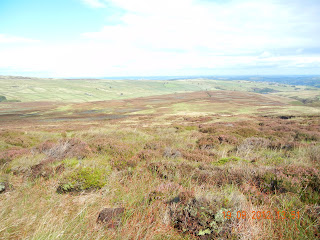It seems improbable, but within half a mile of the start of this session I had taken a wrong turning. This became apparent only when I noticed that there was a river down below rather than the Torside Reservoir. It cost me a good twenty minutes and the best part of a mile of unnecessary walking.
 |
| Not mine! Part of a memorial to a Manchester rambler |
This starts with a gradual ascent up the side of a wide valley, but after a couple of miles the valley of the Crowden Great Brook narrows, and the path climbs quite steeply to run along the escarpment on the West side of the valley. James Crook, my host at the Old House, had warned me that this was eyes down walking, and so it proved. Mostly it was a fairly narrow path, fairly muddy, but there were a number of points where it was necessary to scramble over rocks right at the edge of almost vertical drops. This lasts for a mile or more before the path descends to the stream bed and requires fording smaller lateral streams at frequent intervals. The country becomes less interesting, too – no grand views, and plenty of boggy moorland ground. The final ascent to the top of Black Hill is a long mile and half, but easy going now with paving stones to make it easier to keep out of the wet.
 |
| The view back down Crowden Great Brook to Torside Reservoir |
The Black Hill is another indistinct top marked only with a trig point surrounded by boggy ground and plenty of standing water after all the recent rain. Although this is the highest point for miles, the views are not great: the ground is too level to afford any vistas. The most significant object is a tall television mast a couple of miles away to the East. I had been passed by four or five other walkers, including a South African couple, on the way up. They were sitting comfortably on the plinth of the trig point eating sandwiches when I arrived. Obviously great walkers, but only doing the Crowden to Black Hill section and return that day, and planning to join friends on Offa’s Dyke the following week. It’s strange how one meets people who are doing similar bits of the National Trails when walking in high country.
The Black Hill marks the boundary between Derbyshire and Yorkshire, so now one can claim to have left the Midlands and reached the true North. The descent starts gently, but then becomes steeper. Now there are magnificent views – all across Yorkshire to major cities to the Northeast, and with the cooling towers of two of the great power generating stations (one of which must be Drax) visible on the horizon, perhaps thirty miles away. The nearer views are over the Brownhill and Digby Reservoirs and along gently sloping area of heather – obviously a grouse moor with numbered butts – which I had to traverse before reaching the A635 crossing. This is easier going, though there are dips where one has to cross streams, and is a long gentle descent before a final climb to the road crossing.
 |
| The Crowden Great Brook towards the top of Black Hill |
The lower of eh two reservoirs is just above Wessenden Lodge, which actually looks more like an ordinary farm. I had been told by James Crook that one could avoid losing (and having to regain) height by crossing the dam at the bottom of the reservoir, but the map showed that this would be qt the cost of a long diversion up a valley before reaching the path onward, so I elected to follow the authorised version of the Pennine Way. Rather confusingly it now loses the acorn signs and the Pennine Way
It’s a short sharp climb to regain the main path, and then a long uphill haul to the top, where once again its blanket bog, with the path largely paved. There are then two reservoirs, apparently originally created to provide headwater for the Huddersfield Narrow Canal , which crosses the Pennines with the help of tunnels. Or used to: this is another derelict canal. These are shallow reservoirs on high moorland – relatively dull, open country. The second one is unusual in that it’s dammed at both ends rather than being in a valley. It was also the cause of a tragedy in 1810 when one of the dams burst and caused a huge torrent down on of the local valleys which drowned six people, five from a single family living in a brookside cottage.
 |
| View over Yorkshire from just after the top of Black Hill |
Then it was a drive back to Torside through Yorkshire and Derbyshire. This was a pleasant trip, with the last stretch over the high ground a couple of miles to the East of Black Hill. It reinforced the fact that I had done a lot of climbing (and descending) during the day’s walk.
Back at the Old House there was a very welcome and unanticipated opportunity to change before James ran me into Glossop to catch a train to Manchester and hence back to London
A changeable day with sunshine and showers. Warmer than yesterday – temperature 8 to 17C, but mainly 10 to 12C on the higher stretches. 24.95km, 768m ascent, 631m descents. Open country – lots of rocky, muddy head-down walking, but better going on paths or flagstones for 40% or so of the distance. Several places where streams are crossed on stepping stones.
This was the end of my walking for 2012. Originally I had thought I might put in another week in October, but given the shorter and colder days had decided not to do so. So the rest of the Pennine Way
My totals for 2012 are 990.58km with total ascents of 20,517m.
No comments:
Post a Comment